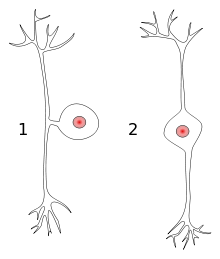Pseudounipolar neuron
| Pseudounipolar neuron | |
|---|---|
| Details | |
| Identifiers | |
| Latin | neuron pseudounipolare |
| Code | TH H2.00.06.1.00047 |

A pseudounipolar neuron (pseudo - false, uni - one) is a kind of sensory neuron in the peripheral nervous system. This neuron contains an axon that has split into two branches; one branch runs to the periphery and the other to the spinal cord.[1]
Central and peripheral axons of a pseudounipolar neuron
By definition, a pseudounipolar neuron has one axon with two branches: central and peripheral. These axonal branches should not be confused with dendrites. These sensory neurons are an exception to the typical neuron, in that they do not have separate dendrites and an axonal process, but rather one branched process that serves both functions.[2] The axon has a peripheral branch (from the cell body to the periphery: skin, joint and muscle) and a central branch (from the cell body to spinal cord).[1]
Anatomy
Pseudounipolar neurons of the dorsal root ganglia
The soma (cell body) of each pseudounipolar neuron is located within a dorsal root ganglion.[2] The axon leaves the cell body (and out of the dorsal root ganglion) into the dorsal root, where it splits into two branches. The central branch goes to the posterior (dorsal) horn of the spinal cord, where it forms synapses with other neurons. The peripheral branch travels through the distal dorsal root into the spinal nerve all the way until skin, joint, and muscle.
Pseudounipolar neurons of sensory ganglia of cranial nerves
Pseudounipolar neurons are also found in the sensory ganglia of cranial nerves V, VII, IX and X, all mixed-cranial nerves. The only other mixed cranial nerve, the vestibulocochlear nerve, has the bipolar neuron type in both the spiral ganglion as well as Scarpa's ganglion.
Signal Pathway
These neurons have sensory receptors on skin, joints, muscles, and other parts of the body. The signal is conducted through the axon to the dorsal root ganglion's cell body, then through the axon and ending at the sensory nuclei in the posterior horn of the spinal cord.
See also
References
- 1 2 Kandel, Eric R.; Schwartz, James H.; Mack, Thomas M. Jessell (2000). Principles of neural Science. (4th ed.). Cambridge: McGrawHill. p. 24. ISBN 978-0838577011.
- 1 2 MacCallum, Don. "Peripheral Nervous System". Histology and Virtual Microscopy Learning Resources. University of Michigan Medical School. Retrieved 24 June 2014.
| ||||||||||||||||||||||||||||||||||||||||||||||||||||||||||||||||||||||||||||